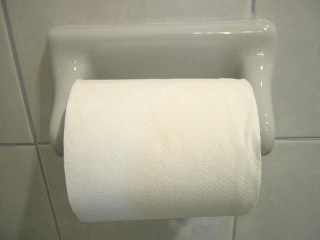
We all use toilet paper(well at least I hope so) but how well is it designed? Prior to this assignment I do not think that I would have ever pondered this question, however, once I began to think about my countless encounters with this everyday thing, I was thinking yes...and then no...and then yes.
Toilet paper was designed for functionality and I think that it certainly serves its purpose. TP is soft - little irritation, flushable - maintains cleanliness, perforated - able to serve for light and heavy messes, and white - visible displays staining.
Lets get into more specifics:
Affordance - When toilet paper is on a role the white color and light perforations do not clearly signal to the user where the beginning of the role is. Countless times I have reached for a toilet paper role and spun the role in both directions in hopes the starting square would reveal itself. Still with no apparent starting square, I spin harder in my frustration again in both directions only to result in miles of toilet paper on the bathroom floor. And im never thrilled about rolling bathroom floor TP back onto the role, eww.
Though, the perforations afford for ease of tearing. Just a little tug and most times the TP separates near that role.
Constraints:
Toilet paper comes in a role. So the toilet paper wall mount was designed to hold and dispense the toilet paper. The role constrains the design of the wall mount. It must allow for easy spinning of the role to release paper. However, to prevent the role from falling off of the mount it must be constrained on both sides of the role. So far so good, but what happens when you want to remove the empty role?

The double bound wall mount calls for a spring held rod to hold the role. To remove the role you must push in one side of the rod to push in the spring and then pull out the empty role. This was extremely challenging for me as a child. In fact, I have had several roommates who must be so frustrated with this design that they never replace a tp role!
Mapping/Visibility
The wall mount rod does not have any visual cues to let the user know how to remove a role. Due to the design constraints the spring loaded rod is concealed by the tp role that it holds which limits the space able to provide visual cues. This hurts the mapping of the design as well. With a concealed part that must be manipulated to remove the role it is hard for a first time user to determine the relationship between the role and the rod.
Ok I could write about this incredibly useful everyday thing all night but alas it is time for class.
Is this design good or bad for you? Or is the real question, is the design flawed enough to go back to diapers?
No comments:
Post a Comment